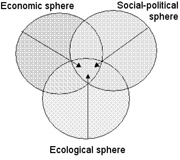NEWSLETTER
Page 4
|
NEWSLETTER |
||
|
Page 4 |
||
| A new model of sustainable development is needed | |
|
Sustainable
development is one of the most misunderstood and over-used concepts in
environmental decision-making today. More often than not it leaves those
tasked with implementing policy confused as to what course of action has
actually been decided upon. In
my opinion the heart of the problem lies with the three pillars model of
sustainable development. It draws a picture of three separate spheres: economic, social and
environmental - each with its own set of values and working according to
its own internal logic. The economic sphere is seen as aiming towards the
creation of material wealth and ensuring growth; the social sphere as
aiming towards improving the quality of life of people and ensuring equity
between people, communities and nations. While the environmental sphere
has to do with protection and conservation of our natural environment This
model of sustainable development strengthens the perception that aspects
of economic activity fall outside of the social sphere and also outside of
the environmental sphere, and that there is only some overlap in certain
areas. But there is not a single aspect of social life that does not lie
wholly in the environmental sphere, that does not have environmental roots
and consequences. In the same manner, all economic activity essentially
comprises social processes Nothing
is said in this model about the manner in which the three pillars interact
with or affect one another, or how they are dependent on one another. In
policy and decision-making, the interaction between the different spheres
is usually reduced to making trade-offs within and between the different
spheres – where costs in one sphere, for example the social or the
environmental, are offset by benefits in the economic sphere. A
far more realistic model of sustainable development is one where the three
separate pillars or spheres are embedded within one another. The widest
circle being environmental, the second circle being social and the central
one being the economic. From this point of view each wider circle serves
as a holding space for the sphere embedded within it, making it not only
possible but also sustaining it in the literal sense of the word. This
image further implies that activities in one sphere may have a negative
impact, even to the point of disruption or destruction, on the larger
sphere. The most important implication of the image of three embedded
spheres, however, is that economic, socio-political and environmental
considerations do not each have their own logic and values separate from
the other spheres. Rather they are intertwined from the outset – to such
an extent that a fundamental rethink is required of everything that we up
until now have conceptualised as economic activity, socio-political
engagement and the environment. PROF
JOHAN HATTINGH |

Another classic representation of sustainable development: The three pillars model
An alternative portrayal of sustainable development in terms of three embedded spheres |
| Local ethics committees should decide how much research participants are paid | |
|
Debate
has emerged in South African health research circles about what
individuals participating in research studies should be paid and who
should decide what that amount is. This is contentious because the payment
should reflect a balance between a
rate of payment that is high enough not to exploit subjects and low enough
that it does not create an
irresistible inducement that encourages people to take risks that may be too high. Views
on participant remuneration range from thoughts that research should be a
socially responsible activity with no payment at all to the view that a
wage payment model should be used in which research subjects are paid an
hourly wage based on that of unskilled workers. Most ethics committees in
South Africa allow an amount of R50 per visit to be paid for travel and
food expenses incurred by the participant for the study visit, and some
committees prefer that this amount not be reflected in the patient
information leaflet. However,
recommendations by the Medicines Control Council (MCC) require that
participants should receive R150 a visit for expenses incurred in
participation in research. The MCC states that the patient should be
issued with an information leaflet with this amount reflected before
deciding whether to participate in the research study. Just
how the money influences the patients decision to take part depends a lot
on the community being researched. A study in the Bishop Lavis and Elsies
River communities in the Western Cape who had participated in two
pharmaceutical industry-sponsored trials of an intranasal flu vaccine said
they used the money received primarily to purchase food for their
families, to transport themselves or a family member to a clinic or
hospital, or to meet cost-of-living expenses generally. In
this setting mentioned above, the standard of R50 per visit for three
study visits spread over 12 months was deemed acceptable – yet it is
likely that other communities with different economic backgrounds may have
substantially different views. The blanket compensation policy that is
being requested by the MCC ignores the complexities of each research project’s specific socio-economic context. In
general, health research ethics guidelines regard the issues of
participant remuneration as residing fairly in the domain of the research
ethics committee involved. We believe it should remain there to ensure that
a decision that best protects the interests of the participants involved
is taken. Summary
of article written by Keymanthri
Moodley and Landon Myer
and published in the South African Medical Journal on 23 September 2003 |
|